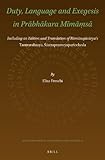Duty, language and exegesis in Prābhāk̄ara Mīmāṃsā : including an edition and translation of Rāmānujācārya's Tantrarahasya, Śāstraprameyapariccheda / by Elisa Freschi.
Material type: TextLanguage: English, Sanskrit Original language: Sanskrit Series: Jerusalem studies in religion and culture ; volume 17.Publication details: LEIDEN ; BOSTON : BRILL, 2012.Description: 1 online resourceContent type:
TextLanguage: English, Sanskrit Original language: Sanskrit Series: Jerusalem studies in religion and culture ; volume 17.Publication details: LEIDEN ; BOSTON : BRILL, 2012.Description: 1 online resourceContent type: - 9789004230248
- 9004230246
- Rāmānujācārya, active 18th century. Śāstraprameyapariccheda. English
- Rāmānujācārya, active 18th century. Śāstraprameyapariccheda. Sanskrit
- 181/.42 23
- B132.M5 F73 2012eb
- online - EBSCO
| Item type | Current library | Call number | URL | Status | Notes | Barcode | |
|---|---|---|---|---|---|---|---|
 eBook
eBook
|
Biblioteca "Angelicum" Pont. Univ. S.Tommaso d'Aquino Nuvola online | online - EBSCO (Browse shelf(Opens below)) | Online access | Not for loan (Accesso limitato) | Accesso per gli utenti autorizzati / Access for authorized users | (ebsco)477010 |
In English and Sanskrit.
Includes bibliographical references and index.
Print version record.
Duty, Language and Exegesis in Prābhākara Mīmāmsā; Copyright; Dedication; Contents; Preface; i. How to Use This Book; i.i. Purpose of the Translation; RĀMĀNUJĀCĀRYA AND THE TANTRARAHASYA; 1. Author and Text; 1.1. Rāmānujācārya; 1.1.1. State of the Research; 1.1.2. A Theist Mīmāmsaka; 1.1.3. Rāmānujācārya's Dates: Internal Evidence; 1.1.4. Rāmānujācārya's Dates: Scholars' Opinions; 1.1.5. Rāmānujācārya's Dates: Concluding Remarks; 1.2. The Tantrarahasya; 1.3. Quotations in the Tantrarahasya; 1.4. Sources; 1.4.1. Śālikanātha and Rāmānujācārya; 1.4.2. Pārthasārathi and Rāmānujācārya.
1.5. Structure of TR IVANALYSIS OF THE CONTENT OF TR IV; 2. Exhortation; 2.1. Bhāvanā and Vidhi According to the Bhāttas; 2.1.1. Current State of Research; 2.1.2. Linguistic Background; 2.1.3. Action and Exhortation; 2.2. Bhātta Theories on Exhortative Expressions in TR IV; 2.2.1. Kumārila's Departure Point (TR IV 3); 2.2.2. Mandana (TR IV 3.1-TR IV 3.1.1); 2.2.3. Bhātta Objections against Mandana (TR IV 3.2); 2.2.4. Alternative Interpretation of Mandana's Theory and Its Refutation (TR IV 3.3); 2.2.5. Is the Prescriptive Force just a Linguistic Fact (TR IV 3.4-TR IV 3.5).
2.2.6. Kumārila Bhatta on the Prescriptive Force as Linguistic Bhāvanā (TR IV 3.6-TR IV 3.7.2.1)2.2.6.1. Śālikanātha's and Rāmānujācārya's Objections (TR IV 3.6-TR IV 3.7.2.1); 2.2.7. The Bhātta-Prābhākara Debate about the Meaning of Verbal Endings (TR IV 3.8-TR IV 3.10); 2.2.8. Further Bhāttas on Cognitions and Mnestic Traces (TR IV 3.13-TR IV 3.14); 2.2.9. Subsumption of Mandana's View (TR IV 3.15-TR IV 3.16.2); 2.2.10. Pārthasārathi against the Idea of a Prescriptive Force as the Exhortative Suffixes' Function (TR IV 3.17-TR IV 3.17.1).
2.2.10.1. Kinds of Incitement (TR IV 3.17, TR TV 9.15)2.2.11. Conclusions; 3. Exhortation and Duty; 3.1. Prābhākara Theories on Exhortative Expressions in TR IV; 3.2. The Sacred Texts' Loop (TR IV 9.1); 3.3. A Possible Way Out (TR IV 9.2); 3.3.1. The Verbal Root Conveys the Action to Be Done (TR IV 9.2); 3.3.2. The Verbal Suffix Conveys the Apūrva (TR IV 9.3, TR IV 3.9-TR IV 3.10, TR IV 9.9); 3.4. Reaching Duty through Metaphor (TR IV 9.3-TR IV 9.3.2; TR IV 9.4-TR IV 9.5.1; TR IV 9.11); 3.4.1. What about Implication (TR IV 3.9; TR IV 3.11-TR IV 3.12); 3.5. Actions and Duty.
3.5.1. Exhortative Suffixes Convey an Action to Be Done (TR IV 9.4-TR IV 9.4.9)3.5.2. An Apūrvakārya Is Recognised Even in Worldly Experience (TR IV 9.6-TR IV 9.7); 3.5.3. Alternative Construction of the Metaphor (TR IV 9.7.1-TR IV 9.9; TR IV 3.1; TR IV 3.3; TR IV 4.1); 3.6. An Unprecedented Duty Does Not Have to Be Grasped (TR IV 9.10-TR IV 9.10.4); 3.6.1. The Double Meaning of 'to Be Done' (TR IV 9.10.5); 3.7. Reasons to Act (TR IV 9.12-TR IV 9.15); 3.8. Epistemological Conclusions of 2 and 3; 4. Hermeneutics of Sacrifice; 4.1. Introduction.
The book is an introduction to key concepts of Indian Philosophy, seen from the perspective of the influential school of Pr?bh?kara M?m??s? (flourished from the 7th until the 20th c. AD). It includes the edition and translation of R?m?nuj?c?rya's??straprameyapariccheda.


